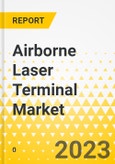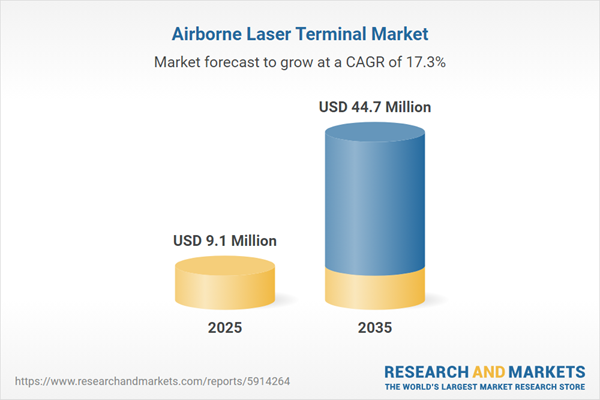This report comes with 10% free customization, enabling you to add data that meets your specific business needs.
Commercial progress followed with Mynaric’s introduction of the HAWK terminal in 2022, designed for aircraft and UAVs. However, production was paused due to technical challenges, signalling the complexities involved in scaling this technology. Despite these hurdles, the airborne laser terminal market continues to be driven by government and defense sector funding, primarily focused on prototype testing and development. As the market progresses, adoption is expected to moderate post-2026, with a transition toward commercial applications, particularly in UAV-based delivery networks and broadband services for airlines. These developments mark the beginning of the airborne laser terminal market's move into its early commercial phase by 2028, as the technology matures and becomes more widely adopted across various sectors.
Market Overview
The global airborne laser terminal market, valued at $8.2 million in 2024, is positioned for substantial growth, with an anticipated CAGR of 17.30% from 2025 to 2035, reaching $44.7 million by 2035. This robust growth is primarily driven by the increasing demand for secure, high-speed communication systems across various sectors, particularly government and defense applications. Among applications, the Government and Defense segment is the fastest growing, as these sectors require reliable, jam-resistant communication solutions for military operations, surveillance, and reconnaissance. In terms of product segmentation, Air-to-Space terminals are witnessing the fastest growth within the airborne laser terminal market, driven by advancements in space-to-air optical communication. Regionally, North America’s market dominates, with the U.S. leading the way through substantial investments in defense and aerospace programs that prioritize airborne laser terminal technologies. These developments are positioning the airborne laser terminal market as a key player in global communication infrastructure, fostering further innovation and commercial adoption.Industrial Impact
The airborne laser terminal market has been making a significant impact across the aerospace, defense, and telecommunications sectors by transforming high-speed, secure communication systems. As the demand for secure, resilient communication solutions grows, the airborne laser terminal market is driving innovations in optical communication technologies, particularly in jam-resistant systems for contested environments. This shift is creating valuable opportunities for technology providers, system integrators, and defense contractors, prompting collaboration across aerospace companies and commercial entities. The growing demand for air-to-ground, air-to-air, and air-to-space laser communication systems is fostering advancements in optical subsystems, turbulence mitigation, and hybrid RF/FSO designs within the airborne laser terminal market. Additionally, the push for standardized optical communication protocols is reducing integration risks and enhancing market accessibility, allowing seamless connectivity with space-based networks. These technological advancements are not only enhancing military communications but also unlocking commercial applications, such as UAV-based networks and in-flight broadband services. Overall, the airborne laser terminal market is contributing to both economic growth and technological progress, solidifying its role in the global communications infrastructure.Market Segmentation:
Segmentation 1: By End User
- Government and Defense
- Commercial
Government and Defense to Lead the Market as the Fastest-Growing End-User Segment (by Application)
The government and defense sectors are expected to drive the fastest growth in the airborne laser terminal market, as they have the most pressing need for high-capacity, resilient communication links in congested and contested electromagnetic environments. With the U.S. Department of Defense's Electromagnetic Spectrum Superiority Strategy highlighting growing risks in RF, there is a clear push toward alternatives offering lower detection probabilities and stronger resistance to jamming, traits inherent to airborne laser communication (lasercom). Mission-critical applications such as ISR backhaul, command and control in contested environments, and emissions control align perfectly with the benefits Lasercom provides. Additionally, defense space architectures are standardizing around optical interoperability, with the Space Development Agency's Optical Communications Terminal (OCT) standard v4.0.0 enabling space-to-air links. Government-funded demos, like NASA Glenn’s Airborne Laser Communication Testbed, have demonstrated the operational viability of lasercom in real turbulence, validating its use in aircraft. These advancements, alongside ongoing defense funding, are accelerating market growth and adoption.Segmentation 2: By Solution
- Air-to-Space
- Air-to-Air
- Air-to-Ground
Segmentation 3: By Component
- Optical Assembly and Subsystems
- Electronics and Signal Processing
- Mechanical and Casing Structure
- Others
Segmentation 4: By Platform
- Aircraft
- Unmanned Aerial Vehicles (UAVs)
- Helicopters
Segmentation 5: By Region
- North America
- Europe
- Asia-Pacific
- Rest-of-the-World
Recent Developments in the Airborne Laser Terminal Market
- In 2025, General Atomics Electromagnetic Systems (GA-EMS) and Kepler Communications successfully demonstrated a two-way optical communication link between an aircraft and a low Earth orbit (LEO) satellite. Using GA-EMS’ Optical Communications Terminal (OCT) integrated in a 12-inch LAC-12 turret, the system maintained a stable connection during flight, proving the viability of SDA-compatible standards for air-to-space data exchange. This breakthrough achievement has placed the technology at TRL 8-9, indicating its near deployment readiness for defense architectures.
- Since 2023, the U.S. Naval Research Laboratory (NRL) has operated a sophisticated testbed to validate optical terminal interoperability built to Space Development Agency (SDA) standards. Simulating orbital conditions, the testbed ensures multi-vendor compatibility for communication across SDA’s proliferated LEO constellations and future air-to-space platforms. The system, now at TRL 8, plays a critical role in establishing reliable procurement processes and technical validation across contractors for scalable airborne and satellite laser networks.
- In 2025, the U.S. Space Systems Command’s Enterprise Space Terminal (EST) Phase-2 initiative selected CACI, General Atomics, and Viasat to develop low-SWaP-C, interoperable optical terminals. These prototypes aim to implement enterprise waveform standards for crosslink and space-to-air connectivity, aligning with the Space Development Agency’s OCT v4.0 framework. By reaching TRL 8-9 maturity, the program establishes interoperability as a procurement standard, facilitating large-scale deployment across defense and commercial domains.
- In 2024, Cucuyo partnered with Cavok UAS to test the P-100 installed on Cavok drones. Following successful flight trials in 2025, this collaboration has demonstrated the technical maturity and real-world applicability of Cayuco’s airborne laser terminal systems.
- In 2023, Airbus and VDL Group began a strategic collaboration to develop and industrialize the UltraAir terminal. The partnership, which includes Airbus designing the system and VDL manufacturing critical components, aims to advance military communications. By 2025, flight testing of the UltraAir terminal will further demonstrate its capabilities in military applications.
- In 2023, Aalyria announced a partnership with Airbus to explore the feasibility of ultra-high-speed optical networks, enhancing connectivity between aircraft, spacecraft, and terrestrial fiber networks. This collaboration will push the boundaries of air-to-ground and air-to-air optical communication, positioning Aalyria at the forefront of next-generation communication technologies.
How can this report add value to an organization?
Product/Innovation Strategy: This report provides an in-depth analysis of the global airborne laser terminal market, focusing on key technologies such as air-to-ground, air-to-air, and air-to-space laser communication systems. By segmenting the market across different applications, including government and defense, commercial aviation, and UAVs, it offers organizations a comprehensive understanding of the specific communication needs for various airborne platforms. The report further explores emerging technologies, such as turbulence mitigation optics, hybrid RF/FSO designs, and standardization efforts like the Space Development Agency’s Optical Communications Terminal Standard, offering product teams valuable insights into innovation opportunities. By identifying trends in high-speed communication, reduced latency, and security, companies can develop tailored solutions that address the evolving demands of the airborne laser terminal market. This segmentation also helps organizations pinpoint areas for product differentiation, ensuring scalability, integration with existing aerospace infrastructure, and long-term operational viability.Growth/Marketing Strategy: As the global airborne laser terminal market grows, driven by increasing demand for secure, high-speed optical communication in aerospace applications, this report helps organizations track market trends and dynamics. Key drivers, such as government defense funding, advancements in UAV technology, and regulatory support for optical communication, are explored to guide marketing teams in aligning their strategies with sector-specific demand. The report highlights high-growth segments, such as air-to-space terminals for satellite communication and air-to-ground solutions for ISR operations, enabling organizations to tailor their value propositions accordingly. With insights into technological advancements, regional developments, and competitor activities, businesses can refine their go-to-market approach, improve customer engagement, and strengthen their competitive positioning in the rapidly advancing airborne laser terminal market.
Competitive Strategy: The report offers a comprehensive competitive analysis of the global airborne laser terminal market, profiling leading players in air-to-ground, air-to-air, and air-to-space communication systems. Competitive benchmarking enables organizations to assess their position against market leaders, evaluating their product offerings, innovation pipelines, and strategic partnerships. Insights into trends such as standardization efforts, government procurements, and emerging applications in commercial aviation and defense provide organizations with an understanding of potential market opportunities and challenges. By analyzing the strengths and weaknesses of key competitors, businesses can refine their competitive strategies, improve product differentiation, and better align their offerings with the evolving needs of the aerospace and defense sectors.
Research Methodology
The primary sources involve industry experts from the airborne laser terminal market and various stakeholders in the ecosystem. Respondents such as CEOs, vice presidents, marketing directors, and technology and innovation directors have been interviewed to obtain and verify both qualitative and quantitative aspects of this research study.The key data points taken from primary sources include:
- validation and triangulation of all the numbers and graphs
- validation of report segmentations and key qualitative findings
- understanding the competitive landscape
- validation of the numbers of various markets for the market type
- percentage split of individual markets for geographical analysis
Secondary Data Sources
This research study involves the usage of extensive secondary research, directories, company websites, and annual reports. It also makes use of databases, such as Hoovers, Bloomberg, Businessweek, and Factiva, to collect useful and effective information for an extensive, technical, market-oriented, and commercial study of the global market. In addition to the aforementioned data sources, the study has been undertaken with the help of other data sources and websites, such as NASA, EDA, and ESA.Secondary research has been done in order to obtain crucial information about the industry’s value chain, revenue models, the market’s monetary chain, the total pool of key players, and the current and potential use cases and applications.
The key data points taken from secondary research include:
- segmentations and percentage shares
- data for market value
- key industry trends of the top players in the market
- qualitative insights into various aspects of the market, key trends, and emerging areas of innovation
- quantitative data for mathematical and statistical calculations
Data Triangulation
This research study involves the usage of extensive secondary sources, such as certified publications, articles from recognized authors, white papers, annual reports of companies, directories, and major databases, to collect useful and effective information for an extensive, technical, market-oriented, and commercial study of the global airborne laser terminal market.The process of market engineering involves the calculation of the market statistics, market size estimation, market forecast, market crackdown, and data triangulation (the methodology for such quantitative data processes has been explained in further sections). The primary research study has been undertaken to gather information and validate the market numbers for segmentation types and industry trends of the key players in the market.
Table of Contents
Companies Mentioned
- Cucuyo GmbH
- General Atomics
- Airbus SE
- NASA (Research Project)
- All-Rays Satellite Technology Co., Ltd.
- Aalyria Technologies, Inc.
- Mynaric AG
- CACI International Inc.
- Cailabs
Table Information
| Report Attribute | Details |
|---|---|
| No. of Pages | 132 |
| Published | November 2025 |
| Forecast Period | 2025 - 2035 |
| Estimated Market Value ( USD | $ 9.1 Million |
| Forecasted Market Value ( USD | $ 44.7 Million |
| Compound Annual Growth Rate | 17.3% |
| Regions Covered | Global |
| No. of Companies Mentioned | 9 |









